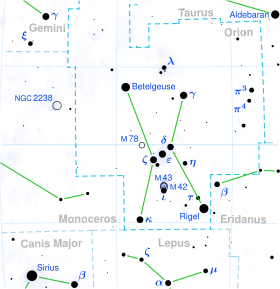HD 44131 is a star in the equatorial constellation of Orion, positioned near the eastern constellation border with Monoceros. It has a reddish hue and is faintly visible to the naked eye with an apparent visual magnitude of 4.91.[2] The star is located at a distance of approximately 465 light years from the Sun based on parallax,[1] and it is drifting further away with a radial velocity of +48.6 km/s.[6] Based on radial velocity variations, it is a candidate spectroscopic binary system and a preliminary orbital solution was published in 1991 with a period of 9.29 yr. However, these velocity variations may be due to other causes.[9]
| Observation data Epoch J2000 Equinox J2000 | |
|---|---|
| Constellation | Orion |
| Right ascension | 06h 19m 59.60059s[1] |
| Declination | −2° 56′ 40.1765″[1] |
| Apparent magnitude (V) | 4.91[2] |
| Characteristics | |
| Evolutionary stage | Asymptotic giant branch[3] |
| Spectral type | M1III[4] |
| U−B color index | +1.96[5] |
| B−V color index | +1.60[5] |
| Astrometry | |
| Radial velocity (Rv) | +48.60[6] km/s |
| Proper motion (μ) | RA: −6.42[1] mas/yr Dec.: −1.26[1] mas/yr |
| Parallax (π) | 7.02 ± 0.23 mas[1] |
| Distance | 460 ± 20 ly (142 ± 5 pc) |
| Absolute magnitude (MV) | −0.86[2] |
| Details | |
| Radius | 55.89+4.05 −4.54[7] R☉ |
| Luminosity | 673±26[7] L☉ |
| Temperature | 3,932+170 −135[7] K |
| Other designations | |
| Database references | |
| SIMBAD | data |

This is an aging red giant star currently on the asymptotic giant branch[3] with a stellar classification of M1III.[4] With the supply of core hydrogen exhausted, this star has cooled and expanded off the main sequence. It is now estimated to have 56 times the radius of the Sun and is radiating 673 times the Sun's luminosity from its swollen photosphere at an effective temperature of 3,932 K.[7] This is a periodic variable of unknown type with a frequency of 0.11212 cycles per day (period of 8.9 days) and an amplitude of 0.0106 in magnitude.[11]
References
edit- ^ a b c d e f Van Leeuwen, F. (2007). "Validation of the new Hipparcos reduction". Astronomy and Astrophysics. 474 (2): 653–664. arXiv:0708.1752. Bibcode:2007A&A...474..653V. doi:10.1051/0004-6361:20078357. S2CID 18759600. Vizier catalog entry
- ^ a b c Anderson, E.; Francis, Ch. (2012). "XHIP: An extended hipparcos compilation". Astronomy Letters. 38 (5): 331. arXiv:1108.4971. Bibcode:2012AstL...38..331A. doi:10.1134/S1063773712050015. S2CID 119257644. Vizier catalog entry
- ^ a b Eggen, Olin J. (July 1992), "Asymptotic giant branch stars near the sun", Astronomical Journal, 104 (1): 275–313, Bibcode:1992AJ....104..275E, doi:10.1086/116239.
- ^ a b Houk, N.; Swift, C. (1999). "Michigan catalogue of two-dimensional spectral types for the HD Stars". Michigan Spectral Survey. 5. Bibcode:1999MSS...C05....0H.
- ^ a b Mallama, A. (2014). "Sloan Magnitudes for the Brightest Stars". The Journal of the American Association of Variable Star Observers. 42 (2): 443. Bibcode:2014JAVSO..42..443M.Vizier catalog entry
- ^ a b Gontcharov, G. A. (2006). "Pulkovo Compilation of Radial Velocities for 35 495 Hipparcos stars in a common system". Astronomy Letters. 32 (11): 759–771. arXiv:1606.08053. Bibcode:2006AstL...32..759G. doi:10.1134/S1063773706110065. S2CID 119231169.
- ^ a b c d Brown, A. G. A.; et al. (Gaia collaboration) (August 2018). "Gaia Data Release 2: Summary of the contents and survey properties". Astronomy & Astrophysics. 616. A1. arXiv:1804.09365. Bibcode:2018A&A...616A...1G. doi:10.1051/0004-6361/201833051. Gaia DR2 record for this source at VizieR.
- ^ "HD 44131". SIMBAD. Centre de données astronomiques de Strasbourg. Retrieved 2020-11-21.
- ^ Mazeh, Tsevi; et al. (July 1996). "Spectroscopic Orbits for Three Binaries with Low-Mass Companions and the Distribution of Secondary Masses near the Substellar Limit". Astrophysical Journal. 466: 415. Bibcode:1996ApJ...466..415M. doi:10.1086/177521.
- ^ "Light Curve". Hipparcos ESA. ESA. Retrieved 11 October 2022.
- ^ Koen, Chris; Eyer, Laurent (March 2002). "New periodic variables from the Hipparcos epoch photometry". Monthly Notices of the Royal Astronomical Society. 331 (1): 45–59. arXiv:astro-ph/0112194. Bibcode:2002MNRAS.331...45K. doi:10.1046/j.1365-8711.2002.05150.x. S2CID 10505995.
